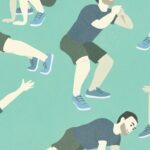In the vibrant tapestry of fitness, exclusivity has long cast a shadow. But as our understanding deepens, a profound shift is underway, beckoning us towards an inclusive haven where individuals of all abilities can embark on their fitness journeys. Enter inclusive fitness services, the beacons of accessibility illuminating the path forward. Join us as we explore this groundbreaking evolution, where fitness transcends barriers and embraces the full spectrum of human potential.
– The Imperative of Inclusivity in Fitness
The Imperative of Inclusivity in Fitness
Fitness facilities play a crucial role in fostering a healthy and active lifestyle for individuals of all abilities. By embracing inclusivity, fitness centers can empower clients with disabilities to enjoy the transformative benefits of physical activity and promote their holistic well-being. Creating an accessible and welcoming environment ensures that all individuals have equal opportunities to engage in fitness activities, regardless of their abilities or limitations.
Benefits of Inclusive Fitness Services:
- Improved Physical and Mental Health: Exercise offers numerous health advantages for individuals with disabilities, including reduced pain, increased mobility, improved balance, and boosted self-esteem.
- Enhanced Socialization and Community Engagement: Fitness facilities provide a platform for socialization and community involvement, fostering a sense of belonging for clients with disabilities.
- Reduced Barriers to Exercise: Adaptive equipment, modified classes, and specialized training programs break down barriers to participation, allowing individuals with disabilities to enjoy physical activity.
– Breaking Barriers: Accessibility for All Abilities
Accessibility is a fundamental human right and should not be limited to certain individuals. In the fitness industry, it’s imperative to provide inclusive services that cater to the needs of clients with disabilities.
Creating accessible fitness environments involves more than just providing ramps or modifications to equipment. It also requires a shift in mindset and attitudes towards individuals with disabilities. Fitness professionals must be adequately trained to assist clients with diverse abilities, ensuring they feel welcomed, respected, and empowered in their fitness journey.
- Tailored Fitness Programs: Develop customized fitness programs that accommodate the specific needs and capabilities of clients with disabilities. This may include modified exercises, alternative equipment, or specialized training techniques.
- Accessible Facilities: Ensure that all fitness facilities are fully accessible, including restrooms, showers, and exercise areas. Provide adaptive equipment and assistive devices to enhance accessibility and safety.
- Inclusive Staff: Train fitness staff to be knowledgeable and respectful of clients with disabilities. This includes understanding their specific needs, providing appropriate assistance, and creating a welcoming and inclusive environment.
[TAGS]
Accessibility in Fitness,
Inclusive Fitness Services,
Fitness for People with Disabilities
– Adaptive Equipment: Empowering Individuals
Adaptive Equipment: Empowering Individuals
Adaptive equipment plays a vital role in ensuring accessibility and inclusivity in fitness spaces. These assistive devices empower individuals with disabilities by providing them with the necessary support, modifications, and enhancements to participate in physical activities and achieve their fitness goals. Adaptive equipment can range from specialized wheelchairs and exercise benches to sensory integration tools and communication aids. By embracing adaptive equipment, fitness professionals can create a welcoming and inclusive environment where everyone has the opportunity to experience the transformative benefits of exercise.
The use of adaptive equipment extends beyond simply enabling participation. It also fosters a sense of confidence and independence among individuals with disabilities. When they have access to the right equipment, they can overcome physical barriers and engage in activities that may have previously seemed impossible. This not only improves their physical health but also boosts their self-esteem and overall well-being. Furthermore, adaptive equipment can help reduce pain and discomfort, making exercise a more enjoyable and sustainable experience.
- Wheelchairs with specialized features for increased mobility and stability
- Exercise benches with adjustable height and support to accommodate various needs
- Sensory integration tools to help individuals with autism or sensory processing disorders
– Modified Exercises: Tailoring Workouts
Adaptive Fitness for All
Ensuring clients with disabilities have access to fitness services requires adaptability and inclusivity in exercise programming. Modified exercises play a crucial role in Tailoring Workouts to accommodate individual needs and abilities. They allow everyone to experience the benefits of physical activity, regardless of their limitations.
Tailoring Workouts with Modified Exercises
- Modify Intensity and Duration: Adjust the intensity and duration of exercises based on a client’s strength, endurance, and stamina. For example, reduce the number of repetitions or sets for weaker clients or provide extra rest periods.
- Substitute Equipment: Use alternative equipment or adaptive devices to make exercises more accessible. Example: For clients with mobility issues, use a seated leg press instead of a standing leg press.
- Provide Assistive Support: Offer assistance during exercises, such as a spotter for weightlifting or a partner to assist with balance or stability.
Tags:
Adaptive Fitness
Modified Exercises
Inclusive Fitness
– Certified Trainers: Expertise and Sensitivity
Certified Trainers: Expertise and Sensitivity
Our team of certified trainers embodies expertise and sensitivity in inclusive fitness. They possess comprehensive knowledge in adaptive techniques, disability-specific modifications, and motivational coaching. Each trainer undergoes rigorous training to develop the skills and empathy necessary to cater to the unique needs of clients with disabilities.
- Empathy and Understanding: Our trainers approach every client with empathy and understanding, fostering a supportive and encouraging environment. They recognize the challenges and strengths of each individual, and work collaboratively to develop personalized fitness plans that promote progress and well-being.
- Personalized Programming: Each client receives a tailored fitness program that aligns with their goals, abilities, and limitations. Trainers assess functional capabilities, identify areas for improvement, and modify exercises to ensure accessibility and effectiveness.
- Adaptive Equipment and Techniques: Our state-of-the-art facility is equipped with specialized equipment and adaptive techniques to accommodate the diverse needs of our clients. From accessible weight machines to sensory aids, our trainers leverage these resources to facilitate a safe and inclusive fitness experience.
Tags:
Disability and Fitness
Certified Trainers
Inclusive Fitness Services
– Creating a Welcoming Environment
Creating an inclusive environment in a fitness center involves recognizing that individuals with disabilities may have unique needs and preferences. It is essential to approach each client with empathy, understanding, and a willingness to accommodate their specific requirements. This may include providing adaptive equipment, offering modified workout routines, or simply being patient and encouraging. By embracing diversity and creating a welcoming space, fitness professionals can help clients with disabilities feel comfortable, valued, and empowered on their fitness journey.
To foster a truly inclusive environment, consider the following strategies:
- Prioritize Accessibility: Ensure that all areas of the fitness center are accessible to individuals with mobility impairments, including ramps, elevators, and wide doorways.
- Provide Adaptive Equipment: Offer specialized equipment such as wheelchairs, handcycles, and adaptive weights to accommodate clients with physical limitations.
- Train Staff: Educate staff on best practices for interacting with clients with disabilities, including proper communication techniques and how to assist with adaptive equipment.
Tags: Inclusive Fitness Services, Accessibility for Clients with Disabilities, Creating a Welcoming Environment
– Beyond the Gym Walls: Outreach and Support
Inclusive Fitness Services: Ensuring Accessibility for Clients with Disabilities
The fitness industry is often seen as a realm for the able-bodied, but in recent years, there has been a growing movement towards inclusivity. An increasing number of gyms are recognizing the need to create fitness spaces accessible for individuals with disabilities. This is a vital step forward in expanding health and wellness within our communities.
Inclusive fitness services encompass a range of modifications and accommodations designed to meet the diverse needs of clients. This can include providing specialized equipment, training staff members on how to work with clients with disabilities, and creating a welcoming and supportive atmosphere. By breaking down barriers to accessibility, fitness centers can empower individuals to prioritize their physical well-being regardless of their challenges.
Key Components of Inclusive Fitness Services:
- Adaptive Fitness Equipment: Specialized equipment designed to support individuals with mobility, cognitive, or sensory impairments.
- Staff Training in Disability Awareness: Education and training of fitness professionals on how to work inclusively with clients with disabilities.
- Accessible Facilities: Designing fitness spaces with features such as ramps, wide doorways, and accessible restrooms ensuring ease of access and movement.
Q&A
Q&A: Creative Conversation on Inclusive Fitness Services
Q: Why is it essential to provide inclusive fitness services?
A: Inclusion fosters a welcoming environment, empowers individuals with disabilities to achieve their fitness goals, and promotes their overall well-being.
Q: What are the key components of inclusive fitness services?
A: Accessibility modifications, adaptive equipment, trained staff, and a mindset that embraces diversity and challenges.
Q: How can fitness facilities enhance accessibility?
A: By installing ramps, widening doorways, providing assistive technology, and offering flexible hours.
Q: Why is staff training crucial for inclusive fitness services?
A: It equips staff with the knowledge, skills, and sensitivity to support clients with diverse abilities.
Q: What role does adaptive equipment play in inclusion?
A: It empowers clients with disabilities by modifying traditional workout equipment to meet their specific needs.
Q: How can we challenge negative stereotypes about disabilities in fitness?
A: By raising awareness, showcasing success stories, and promoting a culture that values inclusivity and diversity.
Q: What are the benefits of incorporating inclusive fitness services?
A: Increased client base, enhanced brand reputation, greater social impact, and the creation of a welcoming community.
Q: How can we ensure long-term sustainability of inclusive fitness services?
A: By establishing partnerships, providing ongoing staff training, and seeking funding opportunities.
Q: What inspiring stories can you share about successful inclusive fitness programs?
A: Share examples of individuals with disabilities overcoming challenges and achieving their fitness goals.
Q: What are the next steps we can take to promote inclusivity in fitness?
A: Advocate for policy changes, educate the community, and hold ourselves accountable for creating truly welcoming environments.
The Way Forward
As we journey towards a more equitable fitness landscape, we must prioritize the inclusion of all individuals. By embracing the principles of inclusive fitness services, we not only empower clients with disabilities but also create a welcoming and empowering environment for everyone. Remember, fitness is not just about physical well-being; it’s about promoting confidence, fostering community, and celebrating the boundless potential that lies within each and every one of us. Let us continue to champion accessibility and strive for a future where all bodies feel valued and capable within the vibrant tapestry of fitness.



